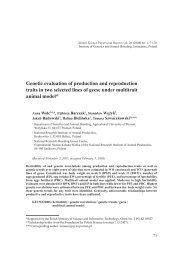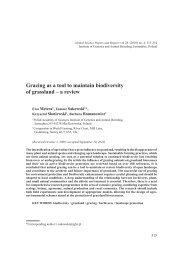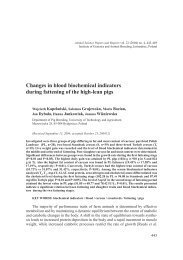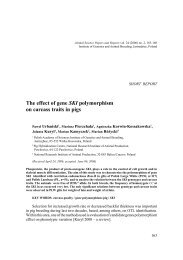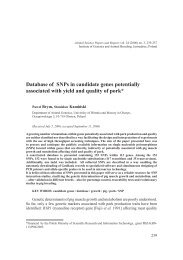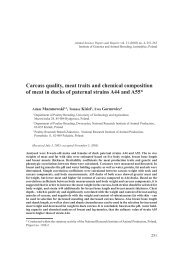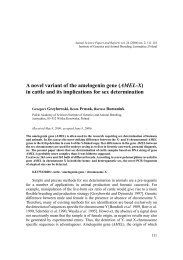Sensitivity and specificity of high-resolution melting analysis in ...
Sensitivity and specificity of high-resolution melting analysis in ...
Sensitivity and specificity of high-resolution melting analysis in ...
You also want an ePaper? Increase the reach of your titles
YUMPU automatically turns print PDFs into web optimized ePapers that Google loves.
Animal Science Papers <strong>and</strong> Reports vol. 28 (2010) no. 2, 161-170<br />
Institute <strong>of</strong> Genetics <strong>and</strong> Animal Breed<strong>in</strong>g, Jastrzębiec, Pol<strong>and</strong><br />
<strong>Sensitivity</strong> <strong>and</strong> <strong>specificity</strong> <strong>of</strong> <strong>high</strong>-<strong>resolution</strong><br />
<strong>melt<strong>in</strong>g</strong> <strong>analysis</strong> <strong>in</strong> screen<strong>in</strong>g unknown SNPs<br />
<strong>and</strong> genotyp<strong>in</strong>g a known mutation*<br />
M.H. Ye 1,2 , J.L. Chen 1 , G.P. Zhao 1 , M.Q. Zheng 1 , J. Wen 1, **<br />
1<br />
The Key Laboratory for Farm Animal Genetic Resources <strong>and</strong> Utilization<br />
<strong>of</strong> the M<strong>in</strong>istry <strong>of</strong> Agriculture <strong>of</strong> Ch<strong>in</strong>a, Institute <strong>of</strong> Animal Science,<br />
Ch<strong>in</strong>ese Academy <strong>of</strong> Agricultural Sciences, Beij<strong>in</strong>g 100094, Ch<strong>in</strong>a<br />
2<br />
College <strong>of</strong> Bioscience <strong>and</strong> Biotechnology, Yangzhou University, Yangzhou 225009, Ch<strong>in</strong>a<br />
(Received August 17, 2009; accepted April 16, 2010)<br />
High-<strong>resolution</strong> <strong>melt<strong>in</strong>g</strong> <strong>analysis</strong> (HRMA) was used to screen potential SNPs <strong>in</strong> the exons <strong>of</strong> chicken<br />
CAPN1 (µ-calpa<strong>in</strong>/large subunit) gene. A total <strong>of</strong> 312 DNA samples from Beij<strong>in</strong>g-you chickens were<br />
used for detection. Twelve pairs <strong>of</strong> primer were designed to amplify twelve different exons <strong>and</strong> SNPs<br />
were detected <strong>in</strong> five <strong>of</strong> them. HRMA was also compared with PCR-SSCP <strong>analysis</strong> for genotyp<strong>in</strong>g <strong>of</strong><br />
a known SNP site <strong>in</strong> the chicken adipocyte fatty acid b<strong>in</strong>d<strong>in</strong>g prote<strong>in</strong> gene (A-FABP). Amplicons <strong>of</strong><br />
275-bp fragment, bracket<strong>in</strong>g the polymorphic site, were grouped by PCR-SSCP <strong>in</strong>to three genotypes<br />
designated as CC, TT <strong>and</strong> CT. Small amplicons (56 bp) with<strong>in</strong> the 275-bp fragments were designed<br />
to maximize the Tm difference between homozygotes <strong>and</strong> to genotype all possible three genotypes<br />
after a s<strong>in</strong>gle <strong>melt<strong>in</strong>g</strong> <strong>analysis</strong> successfully. Results from different methods were cross-validated <strong>and</strong><br />
sequenc<strong>in</strong>g results from r<strong>and</strong>omly selected heterozygotes <strong>and</strong> homozygotes confirmed the <strong>specificity</strong><br />
<strong>of</strong> HRM technique. The full consistency proved that HRMA was a useful tool for rapid, close-tube<br />
genotyp<strong>in</strong>g <strong>of</strong> polymorphic sites. It has great potential for SNPs detection <strong>and</strong> scann<strong>in</strong>g especially<br />
on a large scale.<br />
Key Words: A-FABP / CAPN1 / chicken / HRMA / SSCP <strong>analysis</strong><br />
*Supported by the grant No. 2008AA101009 <strong>and</strong> 2006AA10Z1D8 from National High-tech R&D<br />
Program <strong>and</strong> 2007KLAN003 from State Key Laboratory <strong>of</strong> Animal Nutrition<br />
**Correspond<strong>in</strong>g author: wenj<strong>of</strong>fice@263.net<br />
161
M.H. Ye et al.<br />
In marker-assisted breed<strong>in</strong>g programmes, genetic alterations at functional<br />
genes need to be identified before the association <strong>of</strong> polymorphisms with animal<br />
performance is analysed. In many cases, a large number <strong>of</strong> <strong>in</strong>dividuals <strong>in</strong> a number<br />
<strong>of</strong> populations with diversified genetic backgrounds need to be genotyped before a<br />
positive correlation can be established between a locus <strong>and</strong> a trait <strong>of</strong> <strong>in</strong>terest. S<strong>in</strong>gle<br />
str<strong>and</strong> conformation polymorphism (SSCP) <strong>analysis</strong> is a mutation detection method<br />
widely used [Sun et al. 2008, Wang et al. 2008, Zhang et al. 2009]. For example, the<br />
distribution <strong>of</strong> different genotypes <strong>and</strong> alleles at two SSCP loci <strong>in</strong> chicken tyros<strong>in</strong>ase<br />
gene was studied <strong>in</strong> a total <strong>of</strong> 424 <strong>in</strong>dividuals com<strong>in</strong>g from three Ch<strong>in</strong>ese chicken<br />
breeds <strong>and</strong> an imported Hisex population [Zhang et al. 2008]. Ye et al. [2007]<br />
analysed the distribution <strong>of</strong> different genotypes at three PCR-SSCP loci detected <strong>in</strong><br />
the chicken adipocyte fatty acid b<strong>in</strong>d<strong>in</strong>g prote<strong>in</strong> gene (A-FABP) <strong>and</strong> their relationships<br />
with fat-related traits <strong>in</strong> six Ch<strong>in</strong>ese local chicken breeds on a total <strong>of</strong> 728 <strong>in</strong>dividuals.<br />
SSCP <strong>analysis</strong> has considerable sensitivities <strong>and</strong> does not require <strong>in</strong>tensive labour or<br />
sophisticated <strong>in</strong>struments to perform. But when a targeted gene is to be screened for<br />
potential SNPs or a known SNP is required to be genotyped on a large scale, it is timeconsum<strong>in</strong>g<br />
<strong>and</strong> laborious.<br />
High-<strong>resolution</strong> <strong>melt<strong>in</strong>g</strong> <strong>analysis</strong> (HRMA), <strong>in</strong>troduced <strong>in</strong> 2002 with grow<strong>in</strong>g<br />
popularity, is a powerful mutation-screen<strong>in</strong>g tool [Cho et al. 2008, Jones et al. 2008,<br />
Muleo et al. 2009]. It is a rapid, close-tube method to identify heteroduplex PCR<br />
products [Reed <strong>and</strong> Wittwer 2004]. Unlike conventional <strong>melt<strong>in</strong>g</strong> curve <strong>analysis</strong>,<br />
HRMA with saturat<strong>in</strong>g DNA dye (LCGreen I, Idaho Technology, Salt Lake City,<br />
USA) detects sequence variants with<strong>in</strong> targeted region without the use <strong>of</strong> fluorescently<br />
labeled probes or primers <strong>and</strong> is especially useful for rapid genotyp<strong>in</strong>g. To evaluate<br />
the sensitivity <strong>and</strong> <strong>specificity</strong> <strong>of</strong> HRMA for screen<strong>in</strong>g unknown SNPs <strong>and</strong> genotyp<strong>in</strong>g<br />
known loci, we selected chicken CAPN1 (µ-calpa<strong>in</strong>/large subunit) gene as the target<br />
gene to screen potential SNPs <strong>in</strong> the exons. A known SNP <strong>in</strong> chicken A-FABP gene<br />
was also selected as the target <strong>and</strong> 312 Beij<strong>in</strong>g-you chickens were genotyped by SSCP<br />
<strong>analysis</strong> <strong>and</strong> by HRMA. Sequence alterations were detected by compar<strong>in</strong>g the PCR<br />
product <strong>melt<strong>in</strong>g</strong> pr<strong>of</strong>iles or electrophoretic pattern after SSCP <strong>analysis</strong> with known<br />
homozygous samples <strong>and</strong> results were validated by sequenc<strong>in</strong>g.<br />
Material <strong>and</strong> methods<br />
Animals <strong>and</strong> sampl<strong>in</strong>g<br />
Venous blood samples <strong>of</strong> 312 Beij<strong>in</strong>g-you chickens were obta<strong>in</strong>ed from the<br />
Institute <strong>of</strong> Animal Science, Ch<strong>in</strong>ese Academy <strong>of</strong> Agricultural Sciences. Coagulation<br />
was prevented with citrate <strong>and</strong> samples were stored at -20°C until use. Genomic DNA<br />
was extracted from thawed blood us<strong>in</strong>g the saturated salt method [Sambrook <strong>and</strong><br />
Russell 2001] <strong>and</strong> stored at -20°C.<br />
162
High-<strong>resolution</strong> <strong>melt<strong>in</strong>g</strong> <strong>analysis</strong> for unknown SNPs <strong>and</strong> known mutations<br />
High-<strong>resolution</strong> <strong>melt<strong>in</strong>g</strong> <strong>analysis</strong> (HRMA)<br />
Primers used for screen<strong>in</strong>g s<strong>in</strong>gle nucleotide polymorphisms(SNPs) <strong>in</strong> chicken<br />
CAPN1 gene were designed by Primer 5.0 <strong>and</strong> synthesized by Ubiogene Eng<strong>in</strong>eer<strong>in</strong>g<br />
Co., Ltd., Beij<strong>in</strong>g, Ch<strong>in</strong>a (Tab. 1). PCR was performed <strong>in</strong> a volume <strong>of</strong> 10 μL consist<strong>in</strong>g<br />
<strong>of</strong> about 40 ng <strong>of</strong> genomic DNA, 0.5 μM each <strong>of</strong> forward <strong>and</strong> reverse primers, 1.5 mM<br />
MgCl 2<br />
, 0.25 mM dNTPs, 2 units <strong>of</strong> Taq DNA polymerase (PROMEGA, Madison,<br />
WI, USA), 10 μM LC Green TM I (IDAHO TECHNOLOGY Inc. USA) with 10 μL<br />
m<strong>in</strong>eral oil pipetted <strong>in</strong>to each well on the 96-well PCR plate. PCR amplification was<br />
performed on a thermal block cycler (BioRad c1000, USA). Denatur<strong>in</strong>g (4 m<strong>in</strong> at<br />
94°C) was followed by 32 cycles <strong>of</strong> 30 s at 94°C, 30 s at 58°C, <strong>and</strong> 30 s at 72°C, with<br />
f<strong>in</strong>al 10 m<strong>in</strong> extension <strong>in</strong>cubation at 72°C. After the amplification protocol, an extra<br />
denatur<strong>in</strong>g step was applied (94°C for 30 s) followed by rapid cool<strong>in</strong>g to 25°C to<br />
allow form<strong>in</strong>g heteroduplexes. The amplified samples were melted from 40 to 95°C<br />
at 0.3°C/s <strong>in</strong> the <strong>high</strong>-<strong>resolution</strong> <strong>melt<strong>in</strong>g</strong> device (HR-1; IDAHO TECHNOLOGY<br />
Inc. USA). High <strong>resolution</strong> <strong>melt<strong>in</strong>g</strong> data were acquired <strong>and</strong> analysed us<strong>in</strong>g the<br />
accompany<strong>in</strong>g HR-1 s<strong>of</strong>tware (IDAHO TECHNOLOGY Inc.). In general, <strong>melt<strong>in</strong>g</strong><br />
curves were normalized (temperature ranges on each side <strong>of</strong> the <strong>melt<strong>in</strong>g</strong> transition<br />
were chosen <strong>and</strong> the data po<strong>in</strong>ts for a given sample were scaled between 0 <strong>and</strong> 100%<br />
fluorescent <strong>in</strong>tensity). Temperature was adjusted by superimpos<strong>in</strong>g the temperature<br />
axis <strong>of</strong> each curve over the same temperature range. This aided <strong>in</strong> the differentiation<br />
between homozygotes <strong>and</strong> heterozygotes by emphasiz<strong>in</strong>g curve shape <strong>in</strong> conjunction<br />
with <strong>melt<strong>in</strong>g</strong> temperature.<br />
Table 1. Information <strong>of</strong> primers used for screen<strong>in</strong>g SNPs <strong>in</strong> chicken CAPN1 gene<br />
Primer Sequence Amplicon<br />
calap<strong>in</strong>1-1 F:<br />
R:<br />
calap<strong>in</strong>1-4 F:<br />
R:<br />
calap<strong>in</strong>1-5 F:<br />
R:<br />
calap<strong>in</strong>1-9 F:<br />
R:<br />
calap<strong>in</strong>1-10 F:<br />
R:<br />
5’-CGCAGCTATGATGCCCTTTG-3’<br />
5’-CATGAGCCCAGCACTTACCG-3’<br />
5’-GATCTGGCAGTTTGGTGAGTGGG-3’<br />
5’- GTGGTCGGACTCACTTGGCGTAA-3’<br />
5’-AGGCTGAACGGCTGCTACGAGTC-3’<br />
5’-CTCTGTGAAGAGCAGCGGAACACT-3’<br />
5’- CCACAGGATGTCTTTCCGGGACT-3’<br />
5’- CAAGAGCGGAGATGCGGGAGGTA-3’<br />
5’- CCAGGTGTATCATCCGTGTCTT-3’<br />
5’-GAGCCAGTCTCAAGGAAGTAGCATT-3’<br />
271 bp<br />
149 bp<br />
198 bp<br />
191 bp<br />
242 bp<br />
PCR-SSCP <strong>analysis</strong><br />
The SNP identified at the chicken A-FABP gene was first reported by Ye et al.<br />
[2007]. Primers were designed from the known chicken A-FABP sequence (Genbank<br />
accession AF432507) to generate a 275-bp amplicon correspond<strong>in</strong>g to bases 14 to<br />
288 <strong>in</strong> the published sequence. The primers were 5’-actgctacctggcctgac-3’ (forward)<br />
163
M.H. Ye et al.<br />
<strong>and</strong> 5’-ggaatgtgacaacgctaa-3’ (reverse). It is located <strong>in</strong> the first exon <strong>of</strong> the gene <strong>and</strong><br />
leads to a synonymous codon change from TTC to TTT. In Beij<strong>in</strong>g-you chickens three<br />
genotypes, designated CC, CT <strong>and</strong> TT, were detected at this locus.<br />
PCR was conducted as described above without DNA dye <strong>in</strong> the reaction system.<br />
Specific products <strong>of</strong> the expected size were analysed with SSCP. Two μL <strong>of</strong> the PCR<br />
product were diluted with 5μL <strong>of</strong> a solution conta<strong>in</strong><strong>in</strong>g 98% de-ionized formamide, 10<br />
mM EDTA, 0.025% bromophenol blue, 0.025% xylene cyanol <strong>and</strong> 10% glycerol. The<br />
mixture was denatured at 98°C for 10 m<strong>in</strong>, cooled <strong>in</strong> ice for at least 5 m<strong>in</strong> <strong>and</strong> loaded<br />
on a non-denatur<strong>in</strong>g 12% acrylamide:bis-acrylamide (29:1) gel. Electrophoresis was<br />
performed <strong>in</strong> 1×Tris Borate (pH 8.0) EDTA buffer at 10 volts/cm at 4°C overnight.<br />
DNA was detected by silver sta<strong>in</strong><strong>in</strong>g.<br />
Genotyp<strong>in</strong>g with small amplicons<br />
Small amplicons were designed to dist<strong>in</strong>guish three different genotypes at the<br />
polymorphic site with<strong>in</strong> the A-FABP gene by HRM assay. The forward primer (5’-<br />
cacctggaagctcctttctagtg-3’) consisted <strong>of</strong> 23 bp, correspond<strong>in</strong>g to bases 55 to 77, whilst<br />
the reverse primer (5’-cacccagctctttcatatagtcctc-3’) consisted <strong>of</strong> 25 bp correspond<strong>in</strong>g<br />
to bases 86 to 110. The 3’ nucleotide <strong>of</strong> the reverse primer was just next to the SNP<br />
located at position 85 <strong>of</strong> the known chicken A-FABP sequence (Genbank accession<br />
AF432507); expected length <strong>of</strong> the amplicon was 56 bp. PCR reaction mixture was<br />
the same as described for HRMA. After a denatur<strong>in</strong>g step at 94°C for 4 m<strong>in</strong>, 32 cycles<br />
<strong>of</strong> 10 s at 94°C, 10 s at 58°C, <strong>and</strong> 10 s at 72°C were applied, term<strong>in</strong>at<strong>in</strong>g with a f<strong>in</strong>al<br />
10 m<strong>in</strong> extension <strong>in</strong>cubation at 72°C. High <strong>resolution</strong> <strong>melt<strong>in</strong>g</strong> data were analysed<br />
with HR-1 s<strong>of</strong>tware by fluorescence normalization <strong>and</strong> temperature overlay as<br />
already described. Homozygous genotypes were grouped on the basis <strong>of</strong> two positive<br />
fragments amplified from DNA samples with known genotypes at A-FABP <strong>in</strong>cluded<br />
<strong>in</strong> each plate. A heterozygous sample was produced by mix<strong>in</strong>g (1:1) two amplicons <strong>of</strong><br />
different homozygous samples <strong>of</strong> known genotypes. Derivative plots were visualized<br />
as the negative derivative <strong>of</strong> the fluorescence relative to the temperature (-dF/dT)<br />
versus temperature. These steps allowed visual comparison <strong>of</strong> <strong>melt<strong>in</strong>g</strong> curve shapes<br />
as described by Cecily et al. [2004].<br />
164<br />
Results <strong>and</strong> discussion<br />
Screen<strong>in</strong>g <strong>of</strong> SNPs with HRMA<br />
Differences <strong>in</strong> <strong>melt<strong>in</strong>g</strong> curve shape that correlated to genotype were revealed by<br />
HRMA. Shown <strong>in</strong> Figure 1 are <strong>melt<strong>in</strong>g</strong> curves from homozygous <strong>and</strong> heterozygous<br />
PCR products overlaid at <strong>high</strong> temperature to visually aid comparison. Heterozygotes<br />
could always be easily identified by a change <strong>in</strong> <strong>melt<strong>in</strong>g</strong> curve shape. However,<br />
different homozygotes were not dist<strong>in</strong>guishable from each other. Homozygous samples<br />
had sharper <strong>melt<strong>in</strong>g</strong> transitions, whereas heterozygotes showed broader transitions<br />
because <strong>of</strong> the duplexes formed heterogeneously.
High-<strong>resolution</strong> <strong>melt<strong>in</strong>g</strong> <strong>analysis</strong> for unknown SNPs <strong>and</strong> known mutations<br />
Fig. 1. Genotypes grouped by homozygotes <strong>and</strong> heterozygotes after HRMA (calpa<strong>in</strong>1-10). The grey curves<br />
represent the homozygous genotypes while the red curves represent the heterozygous genotype.<br />
Genotyp<strong>in</strong>g <strong>of</strong> SNP at A-FABP gene by PCR-SSCP <strong>analysis</strong><br />
PCR products from the chicken A-FABP gene were specifically amplified.<br />
Amplicons were obta<strong>in</strong>ed <strong>of</strong> the expected length <strong>of</strong> 275 bp (not shown). After SSCP<br />
<strong>analysis</strong>, three dist<strong>in</strong>guishable PCR-SSCP patterns were obta<strong>in</strong>ed (designated CC, TT<br />
<strong>and</strong> CT (Fig. 2) <strong>in</strong> Beij<strong>in</strong>g-you chickens. A total <strong>of</strong> 312 PCR products were genotyped,<br />
out <strong>of</strong> which 157 samples (50.3%) be<strong>in</strong>g recognized as heterozygotes. Homozygous<br />
TT <strong>and</strong> CC accounted for 26.9% (84) <strong>and</strong> 22.8% (71), respectively.<br />
CT CC CC CC TT TT CC CC CC CT CC CT<br />
Fig. 2. Three genotypes <strong>and</strong> their designations <strong>in</strong> the chicken A-FABP gene, as detected by PCR-SSCP<br />
<strong>analysis</strong>.<br />
Genotyp<strong>in</strong>g with small amplicons<br />
Small amplicons were designed to separate heterozygotes <strong>and</strong> different<br />
homozygotes from each other. Results <strong>of</strong> HRMA for the 56-bps products <strong>in</strong> the chicken<br />
A-FABP gene are shown <strong>in</strong> Figure 3. Heterozygotes can easily be identified by the<br />
double peaks <strong>in</strong> <strong>melt<strong>in</strong>g</strong> curve shape, while the C/G <strong>and</strong> A/T homozygotes hav<strong>in</strong>g<br />
similarly shaped curves (usually with a s<strong>in</strong>gle peak) can be dist<strong>in</strong>guished by a shift <strong>in</strong><br />
<strong>melt<strong>in</strong>g</strong> temperature (Tm) with the Tm <strong>of</strong> the C/G homozygotes approximat<strong>in</strong>g 1°C<br />
<strong>high</strong>er than that <strong>of</strong> the A/T homozygotes (79.3°C <strong>and</strong> 78.6°C, respectively). Grouped<br />
accord<strong>in</strong>g to the positive controls <strong>of</strong> known sequences, results from small amplicons<br />
by HRMA agreed perfectly well with that <strong>of</strong> SSCP <strong>analysis</strong> with three genotypes<br />
recognized right after the <strong>melt<strong>in</strong>g</strong> <strong>analysis</strong>. The complete accordance suggests that<br />
both methods provided results with excellent <strong>specificity</strong> <strong>and</strong> repetitiveness.<br />
165
M.H. Ye et al.<br />
Fig. 3. Three genotypes <strong>of</strong> the chicken A-FABP gene grouped by HRM <strong>analysis</strong>. The grey curves represent<br />
the heterozygous genotype (CT) while the blue <strong>and</strong> red curves represent the homozygous genotypes (CC<br />
<strong>and</strong> TT, respectively).<br />
166<br />
Validation <strong>of</strong> <strong>specificity</strong><br />
A total <strong>of</strong> 12 pairs <strong>of</strong> primer were designed to screen potential SNPs <strong>in</strong> the exons<br />
<strong>of</strong> chicken CAPN1 gene with HRMA. Heterozygotes were detected <strong>in</strong> 5 amplified<br />
fragments (Tab. 1). Sequenc<strong>in</strong>g, which provides simultaneous genotyp<strong>in</strong>g <strong>and</strong><br />
scann<strong>in</strong>g is always considered to be the golden st<strong>and</strong>ard for SNP validation. We<br />
r<strong>and</strong>omly selected 4 heterozygotes for each primer to be sequenced (ABI Prism 3100<br />
Genetic Analyzer, Applied Biosystems). Results showed that double peaks did appear<br />
<strong>in</strong> the sequenc<strong>in</strong>g chromatograms for each heterozygote (Fig. 4), demonstrat<strong>in</strong>g that<br />
HRMA was effective <strong>in</strong> detect<strong>in</strong>g unknown SNPs <strong>in</strong> the target gene (Tab. 2).
High-<strong>resolution</strong> <strong>melt<strong>in</strong>g</strong> <strong>analysis</strong> for unknown SNPs <strong>and</strong> known mutations<br />
Fig. 4. Sequenc<strong>in</strong>g chromatograms for heterozygotes amplified by primer calpa<strong>in</strong>1-10.<br />
Table 2. SNPs detected <strong>in</strong> chicken CAPN1 gene by HRM assay <strong>and</strong> validated by sequenc<strong>in</strong>g<br />
Location <strong>of</strong> SNP <strong>in</strong> CAPN1<br />
gene (Genbank NM_205303)<br />
Amplified Codon <strong>and</strong> AA changed<br />
by primer from to<br />
exon1 (142) calap<strong>in</strong>1-1 UAU(Tyr) UAC(Tyr)<br />
exon4 (499) calap<strong>in</strong>1-4 GAU(Asp) GAC(Asp)<br />
exon5 (676) calap<strong>in</strong>1-5 GGC(Gly) GGU(Gly)<br />
exon9 (1146) calap<strong>in</strong>1-9 CGA(Arg) CAA(Gln)<br />
exon10 (1304) calap<strong>in</strong>1-10 CGG(Arg) UGG(Trp)<br />
As for the known SNP <strong>in</strong> chicken A-FABP gene, we also r<strong>and</strong>omly selected 47<br />
homozygotes (22 <strong>and</strong> 25 for TT <strong>and</strong> CC, respectively) to be sequenced for verification.<br />
There were no false positives <strong>in</strong> a total <strong>of</strong> 47 cases. Homozygotes were identical with<br />
the published variants, <strong>and</strong> the <strong>specificity</strong> was 100%.<br />
There are many ways to genotype SNPs [Chou et al. 2005], <strong>in</strong>clud<strong>in</strong>g denatur<strong>in</strong>g<br />
<strong>high</strong> performance liquid chromatography [Liu et al. 1998], denatur<strong>in</strong>g gradient gel<br />
electrophoresis [Kirk et al. 2002] <strong>and</strong> <strong>high</strong>-density oligonucleotide arrays [Kristensen<br />
et al. 2001]. SSCP <strong>analysis</strong>, one <strong>of</strong> the most commonly used for SNP detection, detects<br />
sequence variations us<strong>in</strong>g conformation sensitive gel electrophoresis [Ganguly et al.<br />
2002, Kunhareang et al. 2008, J<strong>in</strong>g et al. 2008, Hu et al. 2009]. It is not technically<br />
complex <strong>and</strong> is at low cost to perform. However, it requires an extra over-night pastamplification<br />
electrophoretic step <strong>and</strong> cannot be automated for <strong>high</strong>-throughput<br />
<strong>analysis</strong>. This limits its applicability when many samples need to be genotyped<br />
for a known locus or scanned for potential polymorphic loci <strong>in</strong> targeted genes. In<br />
contrast, HRMA is a good c<strong>and</strong>idate to detect sequence variants on a large scale.<br />
We used LCGreen I, the heteroduplex-detect<strong>in</strong>g dye, to screen unknown SNPs <strong>in</strong><br />
chicken CAPN1 gene <strong>and</strong> to genotype a known SNP <strong>in</strong> the chicken A-FABP gene with<br />
HRMA. Unlike SYBR Green I which can only be used <strong>in</strong> limited concentrations,<br />
167
M.H. Ye et al.<br />
LCGreen TM I saturates the products <strong>of</strong> PCR without <strong>in</strong>hibit<strong>in</strong>g amplification <strong>and</strong> does<br />
not redistribute as the amplicon melts, which allows closed-tube genotyp<strong>in</strong>g <strong>analysis</strong><br />
to be performed just after amplification <strong>and</strong> without conjunction with fluorescently<br />
labeled probes [Lay <strong>and</strong> Wittwer 1997, Crockett <strong>and</strong> Wittwer 2001], allele-specific<br />
PCR [Germer et al. 2000], or real-time PCR <strong>in</strong>struments.<br />
Our results showed that HRMA was very sensitive to detect potential SNPs <strong>in</strong><br />
fragments under 300 bp. The <strong>specificity</strong> <strong>of</strong> this method was also verified by a comparison<br />
with PCR-SSCP <strong>analysis</strong>. In the present study, a total <strong>of</strong> 312 samples were genotyped<br />
by PCR-SSCP <strong>analysis</strong> <strong>and</strong> cross-validated by HRMA. When the LightCycler was<br />
used, 96 samples could be analysed simultaneously, with cont<strong>in</strong>uous acquisition <strong>of</strong><br />
fluorescence from 95°C to 40°C with<strong>in</strong> 5 m<strong>in</strong>. Once the PCR was conducted, all the<br />
samples could be genotyped <strong>in</strong> 20 m<strong>in</strong>, which was much time-sav<strong>in</strong>g than with SSCP.<br />
Theoretically, the Tm difference between two homozygotes, aris<strong>in</strong>g from transition<br />
<strong>of</strong> A/T to C/G could be detected by HRMA, which had the sensitivity to differentiate<br />
fragments with a Tm difference <strong>of</strong> 0.3°C. However, we failed to separate two 275-bp<br />
homozygotes at the locus studied <strong>in</strong> chicken A-FABP gene (not shown). We <strong>in</strong>terprete<br />
it as the result <strong>of</strong> decreas<strong>in</strong>g sensitivity with the <strong>in</strong>creas<strong>in</strong>g length <strong>of</strong> PCR fragments.<br />
In this study, we designed small amplicons to genotype three genotypes after PCR<br />
amplification. S<strong>in</strong>ce the Tm differences among genotypes <strong>in</strong>crease with the decrease<br />
<strong>of</strong> amplicon size, the amplicons were made as short as possible (56 bp) <strong>and</strong> the 3’<br />
end <strong>of</strong> each primer was placed very close to the SNP to maximize differentiation. It<br />
was shown that small amplicons, generated with PCR primers bracket<strong>in</strong>g the variable<br />
locus, could dist<strong>in</strong>guish all three genotypes easily. We conclude it to be an effective<br />
method for genotyp<strong>in</strong>g <strong>of</strong> known SNPs on a large scale.<br />
When HRMA was <strong>in</strong>troduced, all test <strong>and</strong> control DNA samples were recommended<br />
to be prepared <strong>in</strong> the same way <strong>and</strong> added <strong>in</strong>to PCR at the same concentration for best<br />
results [Gudrun et al. 2007]. In this study, however, it was <strong>in</strong>convenient to quantify<br />
more than 300 DNA samples. We simplified the procedure by add<strong>in</strong>g different<br />
volumes <strong>of</strong> water to dissolve DNA accord<strong>in</strong>g to the amount <strong>of</strong> white flocculent<br />
precipitate obta<strong>in</strong>ed after ethanol precipitation by experience. Although an average<br />
<strong>of</strong> 1-4 samples <strong>in</strong> each 96-well plate were discarded because <strong>of</strong> aberrant fluorescent<br />
<strong>in</strong>tensity caused by too <strong>high</strong> or low template concentration, good results could still be<br />
obta<strong>in</strong>ed from these crude DNA samples without quantification. We concluded that<br />
if the PCR amplification was specific enough <strong>and</strong> optimized without undesired side<br />
reactions, the limited variation <strong>of</strong> <strong>in</strong>itial DNA concentration could be ignored.<br />
We conclude that HRMA, us<strong>in</strong>g short PCR products for genotyp<strong>in</strong>g, is a rapid,<br />
closed-tube method, sensitive <strong>and</strong> specific <strong>in</strong> genotyp<strong>in</strong>g known <strong>and</strong> detect<strong>in</strong>g<br />
unknown SNPs. Different <strong>melt<strong>in</strong>g</strong> patterns correlate with different genotypes after<br />
a s<strong>in</strong>gle <strong>melt<strong>in</strong>g</strong> <strong>analysis</strong>. It provides a convenient way to detect SNP mutations <strong>in</strong><br />
a targeted gene without perform<strong>in</strong>g full fragment sequenc<strong>in</strong>g. Its simple h<strong>and</strong>l<strong>in</strong>g<br />
<strong>and</strong> greatly <strong>in</strong>creased throughput imply its further application <strong>in</strong> SNPs detection <strong>and</strong><br />
scann<strong>in</strong>g.<br />
168
High-<strong>resolution</strong> <strong>melt<strong>in</strong>g</strong> <strong>analysis</strong> for unknown SNPs <strong>and</strong> known mutations<br />
Acknowledgements. The authors wish to thank W. Bruce Currie <strong>of</strong> Cornell<br />
University, New York, USA for language suggestions on the manuscript.<br />
REFERENCES<br />
1. Cecily P.V., Elenitoba-Johnson Kojo S.J., 2004 – High-Resolution <strong>melt<strong>in</strong>g</strong> <strong>analysis</strong> for<br />
detection <strong>of</strong> <strong>in</strong>ternal t<strong>and</strong>em duplications. Journal <strong>of</strong> Molecular Diagnostics 6, 211-216.<br />
2. Cho M. H., Ciulla D., Kl<strong>and</strong>erman B. J., Raby B. A., Silverman E. K., 2008 – High<strong>resolution</strong><br />
<strong>melt<strong>in</strong>g</strong> curve <strong>analysis</strong> <strong>of</strong> genomic <strong>and</strong> whole-genome amplified DNA. Cl<strong>in</strong>ical Chemistry<br />
54, 2055-2058.<br />
3. Chou Lan-Szu, Ela<strong>in</strong>e L., Wittwer C.T., 2005 – A comparison <strong>of</strong> <strong>high</strong>-<strong>resolution</strong> <strong>melt<strong>in</strong>g</strong><br />
<strong>analysis</strong> with denatur<strong>in</strong>g <strong>high</strong>-performance liquid chromatography for mutation scann<strong>in</strong>g. American<br />
Journal <strong>of</strong> Cl<strong>in</strong>ical Pathology 124, 330-338.<br />
4. Crockett A.O., Wittwer C.T., 2001 – Fluoresce<strong>in</strong>-labeled oligonucleotides for real-time PCR:<br />
us<strong>in</strong>g the <strong>in</strong>herent quench<strong>in</strong>g <strong>of</strong> deoxyguanos<strong>in</strong>e nucleotides. Analytical Biochemistry 290, 89-97.<br />
5. Ganguly A., 2002 – An update on conformation sensitive gel electrophoresis. Human Mutation<br />
19, 334-342.<br />
6. Germer S., Holl<strong>and</strong> M. J., Higuchi R., 2000 – High-throughput SNP allele frequency<br />
determ<strong>in</strong>ation <strong>in</strong> pooled DNA samples by k<strong>in</strong>etic PCR. Genome Research 10, 258–266.<br />
7. Gudrun H. R., Kent J. O., Wittwer C. T., 2007 – High-<strong>resolution</strong> DNA <strong>melt<strong>in</strong>g</strong> <strong>analysis</strong> for<br />
simple <strong>and</strong> efficient molecular diagnostics. Pharmacogenomics 8, 597-608.<br />
8. Hu H.C., Wang H.M., Li J.B., Wang C.F., Lai S.J., Li Q.L., Zhong J.F., 2009 – Genetic<br />
polymorphism <strong>of</strong> Nramp1 gene <strong>and</strong> correlation with mastitis <strong>in</strong> holste<strong>in</strong> cattle. Yi Chuan 31, 57-62.<br />
9. J<strong>in</strong>g Y.J., Lan X.Y., Chen H., Zhang L.Z., Zhang C.L., Pan C.Y., Li M.J., Ren G., Wei<br />
T.B., Zhao M., 2008 – Three novel s<strong>in</strong>gle-nucleotide polymorphisms <strong>of</strong> the bov<strong>in</strong>e LHX3 gene.<br />
Journal Bioscience 33, 673-679.<br />
10. Jones A.V., Cross N.C., White H.E., Green A.R., Scott L.M., 2008 – Rapid identification<br />
<strong>of</strong> JAK2 exon 12 mutations us<strong>in</strong>g <strong>high</strong> <strong>resolution</strong> <strong>melt<strong>in</strong>g</strong> <strong>analysis</strong>. Haematologica 93, 1560-1564.<br />
11. Kirk B.W., Fe<strong>in</strong>sod M., Favis R., Kliman R.M., Barany F., 2002 – Survey <strong>and</strong> summary:<br />
s<strong>in</strong>gle nucleotide polymorphism seek<strong>in</strong>g long term association with complex disease. Nucleic Acids<br />
Research 30, 3295-3311.<br />
12. Kristensen V.N., Kelefiotis D., Kristensen T., Borresen-Dale L., 2001 – Highthroughput<br />
methods for detection <strong>of</strong> genetic variation. Biotechniques 30, 318-332.<br />
13. Kunhareang S., Zhou H., Hickford J.G., 2008 – Allelic variation <strong>in</strong> the porc<strong>in</strong>e MYF5<br />
gene detected by PCR-SSCP. Molecular Biotechnology 41, 208-212.<br />
14. Lay M.J., Wittwer C.T., 1997 – Real-time fluorescence genotyp<strong>in</strong>g <strong>of</strong> factor V leiden dur<strong>in</strong>g<br />
rapid-cycle PCR. Cl<strong>in</strong>ical Chemistry 43, 2262–2267.<br />
15. Liu W., Smith D.I., Rechtzigel K. J., Thibodeau S.N., James C.D., 1998 – Denatur<strong>in</strong>g<br />
<strong>high</strong> performance liquid chromatography used <strong>in</strong> the detection <strong>of</strong> germl<strong>in</strong>e <strong>and</strong> somatic mutations.<br />
Nucleic Acids Research 26, 1396-1400.<br />
16. Muleo R., Colao M.C., Miano D., Cirilli M., Intrieri M.C., Baldoni L., Rug<strong>in</strong>i<br />
E., 2009 – Mutation scann<strong>in</strong>g <strong>and</strong> genotyp<strong>in</strong>g by <strong>high</strong>-<strong>resolution</strong> DNA <strong>melt<strong>in</strong>g</strong> <strong>analysis</strong> <strong>in</strong> olive<br />
germplasm. Genome 52, 252-260.<br />
17. Reed G. H., Wittwer C. T., 2004 – <strong>Sensitivity</strong> <strong>and</strong> <strong>specificity</strong> <strong>of</strong> s<strong>in</strong>gle nucleotide polymorphism<br />
scann<strong>in</strong>g by <strong>high</strong>-<strong>resolution</strong> <strong>melt<strong>in</strong>g</strong> <strong>analysis</strong>. Cl<strong>in</strong>ical Chemistry 50, 1748-1754.<br />
18. Sambrook J., Russell D.W., 2001 – Molecular clon<strong>in</strong>g: A Laboratory Manual. 3rd Ed, Cold<br />
Spr<strong>in</strong>g Harbor Laboratory, New York, USA, 1112-1115.<br />
19. Sun R.P., Wang L.X., Zhu G.Q., Wang J.G., Song Y.X., Liang Z.Y., Cao B.Y., 2008 –<br />
169
M.H. Ye et al.<br />
20.<br />
21.<br />
22.<br />
23.<br />
Polymorphism <strong>of</strong> exon 9 <strong>and</strong> exon 10 <strong>of</strong> GHR gene <strong>and</strong> its relationship with milk performance <strong>of</strong><br />
X<strong>in</strong>ong Saanen dairy goat (<strong>in</strong> Ch<strong>in</strong>ese). Journal <strong>of</strong> Ch<strong>in</strong>a Agricultural University 13, 70-74.<br />
Wang J.L., Zhu Q., Liu Y.P., Du H.R., 2008 – Associations between SNP <strong>of</strong> chicken PRKAB2<br />
gene <strong>and</strong> slaughter <strong>and</strong> meat quality traits (<strong>in</strong> Ch<strong>in</strong>ese). Hereditas (Beij<strong>in</strong>g) 30, 1033-1038.<br />
Ye M.H., Wen J., Cao H.H., Li H.B., Chen J. L., Zhao G.P., Zheng M.Q., 2007 — Study<br />
<strong>of</strong> polymorphysisms <strong>in</strong> adipocyte fatty acid b<strong>in</strong>d<strong>in</strong>g prote<strong>in</strong> gene <strong>and</strong> their relationship with fatness<br />
related traits <strong>in</strong> chickens (<strong>in</strong> Ch<strong>in</strong>ese). Acta Veter<strong>in</strong>aria et Zootechnica S<strong>in</strong>ica 38, 526-532.<br />
Zhang J.Q., Chen H., Sun Z.J., Liu X.L., Qiang B.Y.Z., Gu Y.L., 2008 – Genetic variation<br />
<strong>of</strong> TYR gene <strong>in</strong> different chicken breeds (<strong>in</strong> Ch<strong>in</strong>ese). Acta Veter<strong>in</strong>aria et Zootechnica S<strong>in</strong>ica 39,<br />
1153-1158.<br />
Zhang L P., Gan Q.F., Zhang X.H., Li H.D., Hou G.Y., Li J.Y., Gao X., Ren H.Y., Chen<br />
J.B., Xu S.Z., 2009 – Detect<strong>in</strong>g a deletion <strong>in</strong> the cod<strong>in</strong>g region <strong>of</strong> the bov<strong>in</strong>e bone morphogenetic<br />
prote<strong>in</strong> 15 gene (BMP15). Journal <strong>of</strong> Applied Genetics 50, 145-148.<br />
M.H. Ye , J.L. Chen , G.P. Zhao, M.Q. Zheng, J. Wen<br />
Czułość i specyficzność analizy krzywych topnienia o wysokiej<br />
rozdzielczości w poszukiwaniu nieznanych polimorfizmów<br />
jednonukleotydowych i genotypowaniu znanych mutacji<br />
S t r e s z c z e n i e<br />
Analiza krzywych topnienia o wysokiej rozdzielczości (HRMA) została użyta do poszukiwania<br />
k<strong>and</strong>ydujących polimorfizmów jednonukleotydowych (SNP) w eksonach genu CAPN1 (duża podjednostka<br />
μ-kalpa<strong>in</strong>y) kury. W analizie wykorzystano łącznie 312 próbek DNA od kur Beij<strong>in</strong>g-you. Zaprojektowano<br />
dwanaście par starterów do amplifikacji dwunastu różnych eksonów, a polimorfizmy SNP stwierdzono<br />
w pięciu z nich. HRMA została również porównana z analizą PCR-SSCP w genotypowaniu znanych<br />
odc<strong>in</strong>ków SNP w genie białka wiążącego kwasy tłuszczowe (A-FABP) adipocytów. Amplifikowane<br />
fragmenty DNA o długości 275 bp flankujące miejsce polimorficzne zostały pogrupowane przez<br />
PCR-SSCP w trzy genotypy: CC, TT i CT. Krótkie odc<strong>in</strong>ki amplifikowanego DNA (56 bp), leżące w<br />
obrębie fragmentów o długości 275 bp, zostały użyte w celu zmaksymalizowania różnicy Tm między<br />
homozygotami oraz w celu umożliwienia identyfikacji wszystkich trzech genotypów w pojedynczej<br />
analizie krzywej topnienia. Wyniki uzyskane różnymi metodami były weryfikowane krzyżowo a<br />
sekwencjonowanie losowo wybranych hetero- i homozygot wykazało specyficzność techniki HRMA.<br />
Pełna zgodność wyników wykazała, że HRMA jest użytecznym narzędziem szybkiego genotypowania<br />
miejsc polimorficznych w jednej próbówce (closed tube). Metoda ta umożliwia wydajne wykrywanie i<br />
skanowanie SNP na dużą skalę.<br />
170







